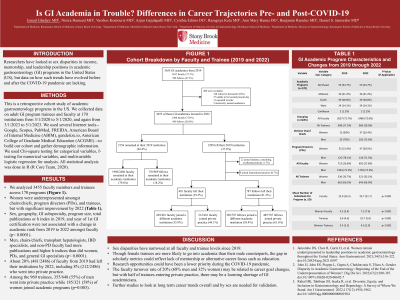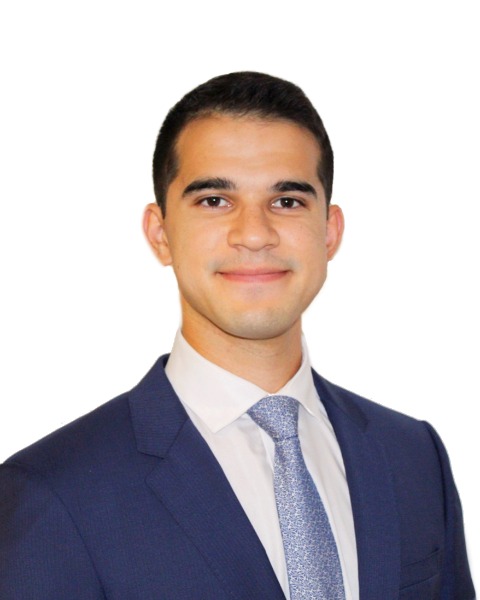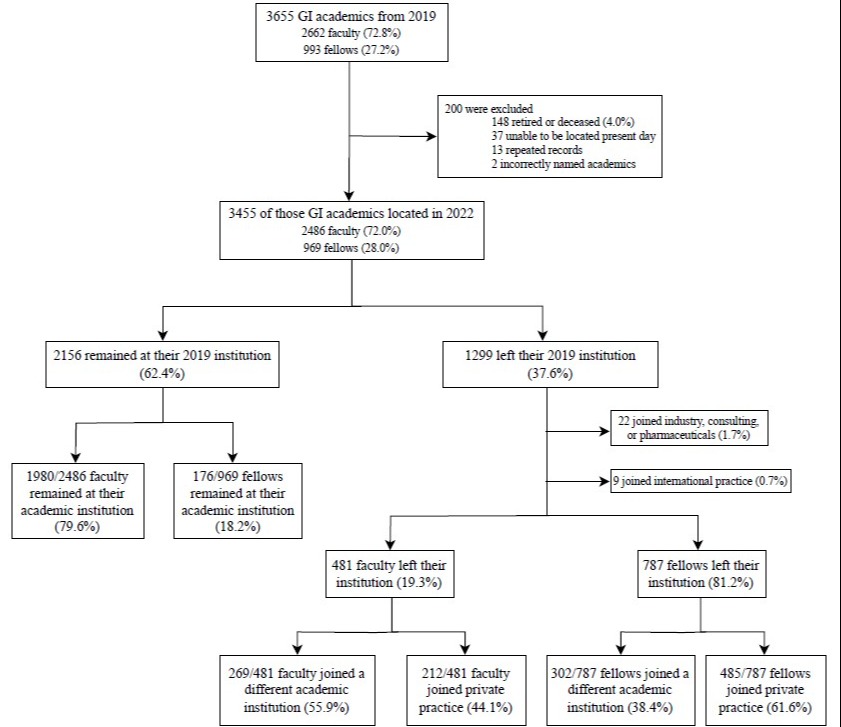Tuesday Poster Session
Category: Practice Management
P4074 - Is Academia in Trouble? Differences in Career Trajectories Pre- and Post-COVID-19
Tuesday, October 24, 2023
10:30 AM - 4:00 PM PT
Location: Exhibit Hall

Has Audio

Ismail Ghafary, MD
Stony Brook University Hospital
Stony Brook, NY
Presenting Author(s)
Ismail Ghafary, MD1, Nimra Hameed, MD1, Vasilios Koulouris, MD2, Arjun Gajulapalli, MD1, Cynthia Edimo, DO1, Rasagnya Kota, MD1, Ann Mary Hanna, DO1, Benjamin Renelus, MD3, Daniel S. Jamorabo, MD4
1Stony Brook University Hospital, Stony Brook, NY; 2Montefiore Medical Center, New York, NY; 3Morehouse School of Medicine, Atlanta, GA; 4Stony Brook Medicine, Stony Brook, NY
Introduction: Researchers have looked at sex disparities in income, mentorship, and leadership positions in academic gastroenterology (GI) programs in the United States (US), but data on how such trend have evolved before and after the COVID-19 pandemic are lacking.
Methods: This is a retrospective cohort study of academic gastroenterology programs in the US. We collected data on adult GI program trainees and faculty at 170 institutions from 3/1/2020 to 5/1/2020, and again from 3/1/2023 to 5/1/2023. We used several Internet tools--Google, Scopus, PubMed, FREIDA, American Board of Internal Medicine (ABIM), genderize.io, American College of Graduate Medical Education (ACGME) --to build our cohort and gather demographic information. We used Chi-square testing for categorical variables, f-testing for numerical variables, and multivariable logistic regression for analysis. All statistical analysis was done in R (R Core Team, 2020).
Results: We analyzed 3455 faculty members and trainees across 170 programs (Figure 1). Women were underrepresented amongst chairs/chiefs, program directors (PDs), and trainees, but with significant improvement by 2022 (Table 1). Sex, geography, GI subspecialty, program size, total publications or h index in 2019, and year of 1st GI certification were not associated with a change in academic rank from 2019 to 2022 amongst faculty. Men, chairs/chiefs, transplant hepatologists, IBD specialists, and non-PD faculty had more publications and higher h indices than did women, PDs, and general GI specialists (p< 0.0001). About 20% (481/2486) of faculty from 2019 had left their institutions by 2022, including 8% (212/2486) who went into private practice. Among the 969 trainees, 355/648 (55%) of men went into private practice while 185/321 (58%) of women joined academic programs (p=0.003).
Discussion: Sex disparities have narrowed at all faculty and trainee levels since 2019. Though female trainees are more likely to go into academia than their male counterparts, the gap in scholarly metrics could reflect lack of mentorship or alternative career focus such as education. Research opportunities could have been a lower priority during the COVID-19 pandemic. The faculty turnover rate of 20% (68% men and 32% women) may be related to career goal changes, but with half of trainees entering private practice, there may be a looming shortage of GI academicians. Further studies to look at long term career trends overall and by sex are needed for validation.

Disclosures:
Ismail Ghafary, MD1, Nimra Hameed, MD1, Vasilios Koulouris, MD2, Arjun Gajulapalli, MD1, Cynthia Edimo, DO1, Rasagnya Kota, MD1, Ann Mary Hanna, DO1, Benjamin Renelus, MD3, Daniel S. Jamorabo, MD4. P4074 - Is Academia in Trouble? Differences in Career Trajectories Pre- and Post-COVID-19, ACG 2023 Annual Scientific Meeting Abstracts. Vancouver, BC, Canada: American College of Gastroenterology.
1Stony Brook University Hospital, Stony Brook, NY; 2Montefiore Medical Center, New York, NY; 3Morehouse School of Medicine, Atlanta, GA; 4Stony Brook Medicine, Stony Brook, NY
Introduction: Researchers have looked at sex disparities in income, mentorship, and leadership positions in academic gastroenterology (GI) programs in the United States (US), but data on how such trend have evolved before and after the COVID-19 pandemic are lacking.
Methods: This is a retrospective cohort study of academic gastroenterology programs in the US. We collected data on adult GI program trainees and faculty at 170 institutions from 3/1/2020 to 5/1/2020, and again from 3/1/2023 to 5/1/2023. We used several Internet tools--Google, Scopus, PubMed, FREIDA, American Board of Internal Medicine (ABIM), genderize.io, American College of Graduate Medical Education (ACGME) --to build our cohort and gather demographic information. We used Chi-square testing for categorical variables, f-testing for numerical variables, and multivariable logistic regression for analysis. All statistical analysis was done in R (R Core Team, 2020).
Results: We analyzed 3455 faculty members and trainees across 170 programs (Figure 1). Women were underrepresented amongst chairs/chiefs, program directors (PDs), and trainees, but with significant improvement by 2022 (Table 1). Sex, geography, GI subspecialty, program size, total publications or h index in 2019, and year of 1st GI certification were not associated with a change in academic rank from 2019 to 2022 amongst faculty. Men, chairs/chiefs, transplant hepatologists, IBD specialists, and non-PD faculty had more publications and higher h indices than did women, PDs, and general GI specialists (p< 0.0001). About 20% (481/2486) of faculty from 2019 had left their institutions by 2022, including 8% (212/2486) who went into private practice. Among the 969 trainees, 355/648 (55%) of men went into private practice while 185/321 (58%) of women joined academic programs (p=0.003).
Discussion: Sex disparities have narrowed at all faculty and trainee levels since 2019. Though female trainees are more likely to go into academia than their male counterparts, the gap in scholarly metrics could reflect lack of mentorship or alternative career focus such as education. Research opportunities could have been a lower priority during the COVID-19 pandemic. The faculty turnover rate of 20% (68% men and 32% women) may be related to career goal changes, but with half of trainees entering private practice, there may be a looming shortage of GI academicians. Further studies to look at long term career trends overall and by sex are needed for validation.

Figure: Cohort Breakdown by Faculty and Trainee (2019 and 2022)
Disclosures:
Ismail Ghafary indicated no relevant financial relationships.
Nimra Hameed indicated no relevant financial relationships.
Vasilios Koulouris indicated no relevant financial relationships.
Arjun Gajulapalli indicated no relevant financial relationships.
Cynthia Edimo indicated no relevant financial relationships.
Rasagnya Kota indicated no relevant financial relationships.
Ann Mary Hanna indicated no relevant financial relationships.
Benjamin Renelus indicated no relevant financial relationships.
Daniel Jamorabo indicated no relevant financial relationships.
Ismail Ghafary, MD1, Nimra Hameed, MD1, Vasilios Koulouris, MD2, Arjun Gajulapalli, MD1, Cynthia Edimo, DO1, Rasagnya Kota, MD1, Ann Mary Hanna, DO1, Benjamin Renelus, MD3, Daniel S. Jamorabo, MD4. P4074 - Is Academia in Trouble? Differences in Career Trajectories Pre- and Post-COVID-19, ACG 2023 Annual Scientific Meeting Abstracts. Vancouver, BC, Canada: American College of Gastroenterology.
